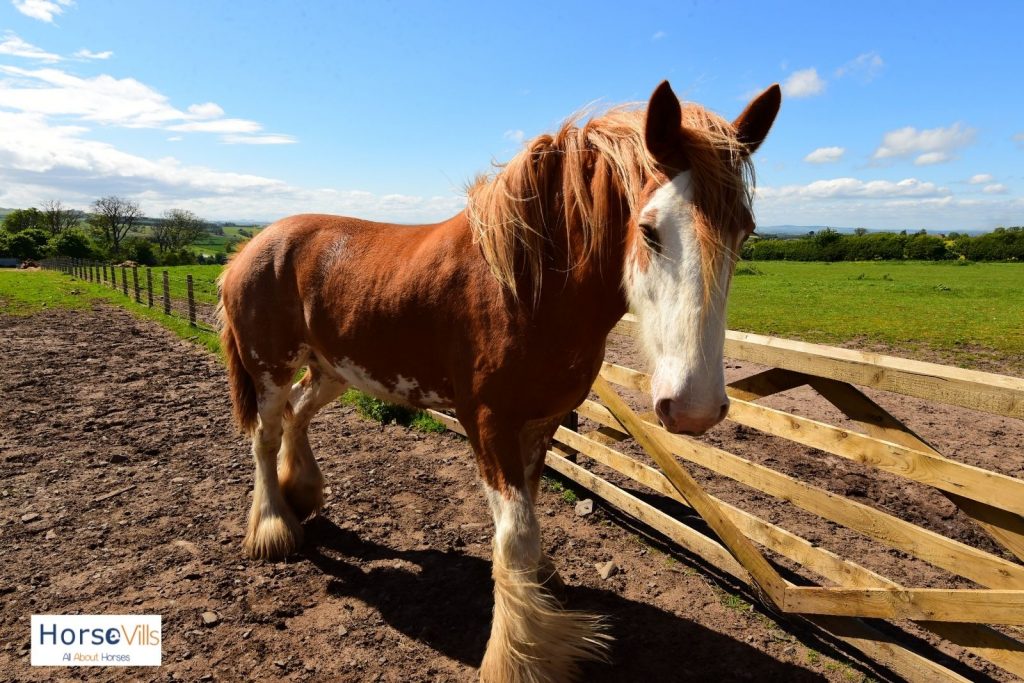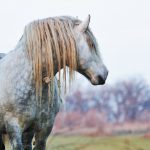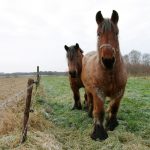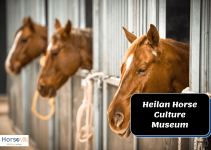When looking at large horse breeds, such as a draft, it is easy to assume they only pull heavy loads, but you can ride them as well, including Clydesdale riding.
Can you ride a Clydesdale?
More recently, equestrians have realized that the Clydesdale is a great riding horse.
If you’re looking for information on Clydesdale riding and other facts and characteristics about this beautiful horse, you’ve come to the right place! Let’s take a look.
READ MORE: What Horse is Bigger Than Clydesdale?
Table of Contents
Clydesdale Horse
The Clydesdale horse is one of the most recognized horse breeds.
It is also one of the largest types of horse in height and weight.

Clydesdale Origin
The Clydesdale horse originates in Scotland. Development of the breed started in Clyde, an area of Lanarkshire. Farmers in the region were in need of a bigger, stronger horse to work the land than the native horses.
History of the Clydesdale
During the 18th and 19th centuries, farmers in Scotland wanted a horse suitable to carry out heavy farm work. In Lanarkshire, where the Clydesdale hails from, you will find the River Clyde.
It is this river that the name of this breed comes from. Not only did the Clydesdale work on Scottish farms, but it also pulled carts loaded with coal from the region’s coal mines.
In the early 18th century, the 6th Duke of Hamilton set out to solve the problem of suitable heavy workhorses. To do this, the Duke imported several Flemish horses to breed with local stock.
This early breeding laid the base for the breed and Blaze, the horse that is considered the Clydesdale’s foundation stallion. Blaze was born in 1775.
With selective breeding and the introduction of Shire horse blood, the Clydesdale was born. A Shire horse is another type of heavy horse that originated in the United Kingdom.
Even though the Shire tends to be even bigger than the Clydesdale, if you can imagine that, the two breeds are very similar.
The development of the Duke’s vision was a huge success. Soon the news of this wonderful breed spread to England. To establish a breed standard, Lanarkshire set up societies the offered stallions for hire.
The earliest society on record dates to 1837. By 1877, we see the formation of the Clydesdale Horse Society, which was responsible for promoting the breed in the rest of the United Kingdom and beyond.
Arrival in the United States
In the late 19th century, when many people immigrated to the United States, the Clydesdale made its first appearance in the country. The horses arrived in the United States with Scottish immigrants.
At that time in the US, there was a need for powerful, heavy horses to pull plows and machinery. The Clydesdale was an excellent candidate for this role.
The American Clydesdale Association was founded in late 1879 and served as the main Clydesdale breed register for the United States and Canada.
By 1882, the society had complied and distributed the first American studbook.
When the industrial revolution occurred, machinery began to replace horses for many farming and commercial activities.
This had an extremely detrimental effect on the Clydesdale and other heavy horse breeds.
The effect was so damaging to the breed it was at risk of extinction. In addition to replacing horses in their main jobs, the Clydesdale was also called up to take part in World War I.
The war also greatly affected the breed’s population numbers.
Clydesdale Horse Breeds
The Clydesdale is its own breed of horse carefully developed to pull heavy carts and farm machinery.
There is only one Clydesdale type, and similar characteristics and temperament run through the breed.
It is often referred to as a gentle giant.

Characteristics
Most Clydesdales are bay with striking white markings. It is this look that most people associate with the breed, thanks to the Budweiser Clydesdales.
They have abundant feathers on their legs, tall white socks, and wide blazes on their face. However, not every horse will have these preferred markings. Also, some Clydesdale coats show roaning.
Roaning is when white hair mixes with the base coat color. More rarely, you will see a solid Clydesdale with no white markings. Also, uncommon are Clydesdales with black, gray, and chestnut horse coat colors.
All Clydesdales can join their regional breed registry. However, the majority of people want a horse without roaning, a bay coat, tall white socks, and a blaze.
The hooves of a Clydesdale are huge! Take a look at a standard dinner plate, that is close to the size of their hooves.
Not only are the Clydesdale’s feet enormous, but they also weigh five pounds each.
The confirmation of the breed is a broad, compact, muscular body. These horses are built for power! And boy do they have it! It is a massive horse!
The Clydesdale has an active high stepping trot, a high set, arched neck, and a broad forehead. The body is compact with a wide barrel, which helps with the horse’s power and durability.
Temperament
If you are new to horses, you might find the Clydesdale intimidating at first due to its sheer size. Even experienced equestrians might take it slow around one of these horses if they are not around them often.
However, don’t let this fool you. The Clydesdale is a calm, gentle horse the enjoys the company of people.
They like to work and please, making them wonderful equine companions for a variety of activities.
Clydesdale Riding Horse
To revitalize and save the breed societies actively promote the good qualities of the Clydesdale. One of the biggest influences on saving this breed is its use as a mascot for Budweiser.
However, pulling carts or giving wagon rides is not the only thing that a Clydesdale can do. It also makes an excellent riding horse.
The calm, intelligent, and non-spooky temperament of the Clydesdale means that it is a good choice for beginners.
It is also a wonderful pleasure mount for those who want to enjoy dependable trail riding horses. Due to their size, the Clydesdale is a suitable mount for very tall or larger riders.
You will also find the breed in special events such as parades and doing patrol work. They are a comfortable ride with a smooth, ground-covering step. You can also use a Clydesdale for dressage.
They are easy to train, which means they can learn the basics of riding quite quickly. While the Clydesdale will never have the ability to reach upper-level dressage, they are perfect for an amateur that wants a sensible, quiet horse to compete at the lower levels.
READ MORE: Names of Horse Breeds
Clydesdale Horse
As you can see, Clydesdale riding is a real and often overlooked possibility.
They are relatively inexpensive to buy if you are looking for a reliable family horse. However, they do cost more to keep.

Let’s keep going to learn more about this beautiful horse.
Breed Overview
In addition to the color of the Clydesdale, which we’ve already introduced you to, we’re now going to take a look at other physical characteristics of the breed.
The Clydesdale will stand between 16 and 18 hands tall, with an average height of 16.2 hands. They weigh anywhere from 1,600 to 2,200 pounds. A foal will weigh around 180 pounds at birth!
What Type of Horse is a Clydesdale
The Clydesdale is one of the draft breeds. What is a draft horse? Well, a draft breed horse is a type of cold blood horse.
There are three blood categories, hot, warm, and cold.
Hot blood horses have the fieriest temperament, this includes the Arabian and the Thoroughbred.

A warmblood falls in the middle and has more athletic ability than cold blood. It is in this category where you will find most sport horses, such as the American Quarter Horse, Holsteiner, and the Dutch Warmblood.
A draft horse is a heavy horse that was developed for working a farm or pulling heavy loads. All draft horses share similar qualities.
These include gentle, calm dispositions, incredible strength, muscular bodies, and height.
Other draft horse breeds include the Shire, Percheron, and Belgian. Today, draft horses still perform the tasks they were bred for, such as working on farms and in forestry.
There are also pulling competitions where teams of draft horses compete to see who can pull the heaviest weight.
Grooming A Clydesdale
The Clydesdale will require some special grooming treatment. This is because they have heavy feathering on their legs. You will need to brush the feathers daily to keep them in top condition.
It is also necessary to keep the leg hair clean and dry. If you wash the legs of a Clydesdale, you must always dry them manually afterward to avoid unpleasant skin conditions.
The Clydesdale Is A Rare Breed
Even with the help of the breed society and Budweiser, the Clydesdale is still an at risk breed.
Today, the majority of Clydesdales are born in the United States, thanks to the Budweiser breeding farm, which breeds over 50 foals each year.

Around the world, there are only around 5,000 Clydesdales. In the US, an average of 600 Clydesdale foals is born each year. The other most common regions for Clydesdale populations are Canada, the United Kingdom, and Australia.
ALSO READ: Quarter Horse vs Thoroughbred
Clydesdale Interesting Facts
There are several interesting facts about the Clydesdale we thought we’d share with you.
As you noticed, Clydesdale has an abundance of feathers on its legs.
While it is not the only horse breed with this, it has a stronger genetic predisposition for it than the others.

The theory is that over time the breed developed this strong genetic factor to cope with the environment of Scotland, which is cold and wet in the winter.
While good confirmation is desired for all horses, including the Clydesdale, the standard for the breed is slightly unusual.
The preferred traits in a Clydesdale are sometimes confirmation characteristics that breeders try to avoid in other breeds. For example, it is desirable for Clydesdale to have hocks that point inwards.
This is otherwise known as ‘cow hocked’. However, for the Clydesdale, having cow hocks allows the horse to move on a single track behind. In other words, they place one hind foot in front of the other.
This is beneficial when the breed is plowing a field, as they can walk in dips and not the raised ground creating by the plow.
FAQs
Have some questions about Clydesdale? We’ve tackled a few of them here. Check it out.
HOW LONG DO CLYDESDALE HORSES LIVE?
The lifespan of a Clydesdale is pretty close to most other types of horse breeds. The average life expectancy of the breed is 20 to 25 years old.
WHAT HORSE IS BIGGER THAN A CLYDESDALE?

While Clydesdale is a huge horse, it is not the biggest breed. Both the Shire and Belgian Draft are, on average, are taller, though they are all heavy in body type. The Percheron is also usually taller and heavier than a Clydesdale.
IS a BELGIAN OR CLYDESDALE BIGGER?

The Belgian draft is usually bigger than a Clydesdale. This applies more to their weight than their height. Both breeds tend to average around the same height. However, the Belgian tends to have a little more height. The biggest Belgian horse on record weighed an impressive 3,000 pounds.
HOW MUCH DO CLYDESDALES EAT?

The Clydesdale eats more than an average horse because they have much bigger bodies. They eat an average of 25 to 50 pounds of hay each day, plus another 2 to 4 pounds of grain. This is a lot of food, and it will cost twice as much to feed a Clydesdale as a smaller horse.
WHAT IS THE BIGGEST HORSE EVER?
The biggest horse on record is a Shire named Sampson. Sampson stood an amazing 21.2 hands tall and weighed 3,360 pounds. Sampson was born in England, in 1846.
WHAT COLOR EYES DOES A CLYDESDALE HAVE?
A Clydesdale has brown eyes like most horses. Blue-eyed horses are quite rare, with less than 10 percent of horses having one or two blue eyes. It is most common to see blue eyes in horses with a dilution gene.
Conclusion
If you were unfamiliar with Clydesdale before, we hope you are now filled with information. As you can see, the Clydesdale is a versatile horse, with many excellent characteristics.
They make wonderful family horses, and riding mounts for novice riders and different skill levels.
Have you ever ridden a Clydesdale? We want to hear all about your experience, so let us know!
References
- “14 Interesting Clydesdale Horse Facts.” Karina Brez Jewelry, karinabrez.com/blogs/news/14-interesting-clydesdale-horse-facts. Accessed 13 July 2021.
- “Clydesdale.” International Museum of the Horse, imh.org/exhibits/online/breeds-of-the-world/europe/clydesdale. Accessed 13 July 2021.
- Clydesdale Horse. www.theequinest.com/breeds/clydesdale/. Accessed 13 July 2021.
- Henry, Miles. Are Belgian Horses Bigger than Clydesdales? Plus Quick Facts. horseracingsense.com/are-belgian-horses-bigger-than-clydesdales/. Accessed 13 July 2021.

Have you tried Clydesdale riding? Please share your experience below!
Siun is an all-around animal lover, with a passion for horses. She grew up in the United States, competing in the hunters, equitation, and jumpers. Now living in Ireland, she competes with her own showjumping horses. She is experienced in the care and training of horses, as well as teaching riding lessons. She loves to combine her love for horses with her work. When not working, Siun will be found at the stables, rain or shine.
Find her on FACEBOOK
Read her latest ARTICLES.
Learn more about HER



![The Shire Horse Size Comparison Chart [Comprehensive Guide]](https://horsevills.com/wp-content/uploads/2023/06/Shire-Horse-Size-Comparison-211x150.jpg)